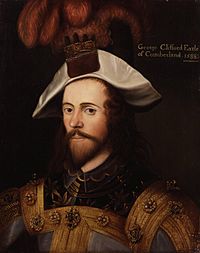Battle of the Berlengas (1591) facts for kids
The Battle of Berlengas Islands was a sea fight near Portugal on July 15, 1591. It happened during the war between England's Queen Elizabeth I and Spain's King Philip II. This battle involved an English group of ships led by George Clifford, 3rd Earl of Cumberland. He was a "privateer," which means he was a ship owner who had permission from his government to attack enemy ships and take their goods. The English ships fought against five Spanish galleys (long, oar-powered ships) led by Francisco Coloma. The Spanish ships were guarding the Portuguese coast from privateers. The English ships were surprised while anchored near the Berlengas islands. The Spanish galleys managed to capture one English ship and get back two other ships the English had taken earlier.
Quick facts for kids Battle of Berlengas Islands |
|||||||
|---|---|---|---|---|---|---|---|
| Part of the Anglo-Spanish War (1585–1604) | |||||||
 George Clifford, 3rd Earl of Cumberland, after Nicholas Hilliard, c. 1590. |
|||||||
|
|||||||
| Belligerents | |||||||
| Commanders and leaders | |||||||
| Earl of Cumberland William Monson (POW) |
Francisco Coloma | ||||||
| Strength | |||||||
| 5 warships | 5 galleys | ||||||
| Casualties and losses | |||||||
| 1 warship captured, 2 prizes recovered, "Captain and principal men slain", 150+ prisoners | 2 killed | ||||||
Contents
Cumberland's Journey to Portugal
In the spring of 1591, the Earl of Cumberland started a new privateering trip. He had already led naval trips to Spain's coasts in earlier years. For this journey, he sailed with his best ship, the 600-ton Garland, which was a royal ship. He also brought four of his own ships: the Sampson, the Golden Noble, Allegarta, and a small scout ship called Discovery.
Sir William Monson, who later became an important admiral in the English Royal Navy, was his second-in-command.
Taking Prizes and Challenges
Near the Spanish coast, Cumberland's group captured two ships from the Dutch Republic. These Dutch ships were sailing from Lisbon with spices. Even though the Dutch were allies with England against Spain, these ships carried goods belonging to Portuguese merchants.
Sir William Monson later wrote about how the Dutch traded with Spain. He said they supplied the Spanish with important things like ammunition and food.
The English group captured more ships. They took one ship full of wine and two ships carrying sugar. These "prizes" were sent back to England. One of the sugar ships had a hole and had to be left behind. Its crew was saved on shore. The other two prize ships faced bad winds and ran out of supplies. They had to enter the port of A Coruña in Spain, where they were immediately captured by the Spanish.
Meanwhile, the English squadron sailed to the Berlengas islands. These are small islands off the coast of Portugal, near the city of Peniche.
Separation of the Fleet
At the Berlengas islands, the Earl of Cumberland told Monson to take the captured Dutch ships back to England. Captain Peter Baily's ship, the Golden Noble, was to escort them. However, during the night, Cumberland's main ship, the Garland, and the other warships got separated from Monson and the prize ships.
The Battle Begins
The Golden Noble was spotted by five Spanish galleys. These galleys were part of the "Coast-guard armada," led by Francisco Coloma. Archduke Albert, who was the Spanish ruler of Portugal, knew that English privateers were in the area. He had sent Coloma's ships to patrol the coast.
Spanish Attack
Because the sea was calm, the Spanish galleys could row quickly towards the English ships. They attacked the Golden Noble and its prizes. After a fierce fight, the Spanish captured the English ships. Captain Peter Baily and the main officers of the Golden Noble were killed during the battle.
Coloma captured the Golden Noble, which had 14 guns and 150 men. He also got back the two Dutch prize ships. The Spanish lost only two men in the fight.
Cumberland heard the sound of cannons from Monson's ship in the distance. But he could not get there to help because the winds were against him.
After the Battle
After the battle, Cumberland wrote to Archduke Albert. He asked that the English prisoners be treated well. He warned that if they were harmed, he would treat Spanish prisoners with "double severity."
Monson was among the prisoners. He was taken to Portugal and held for two years in prisons at Cascais and Lisbon. Six other officers were also imprisoned. The regular sailors and soldiers were given new clothes and set free. Monson spent several months as a "galley slave" on a Spanish galley called the Leiva. This meant he had to row the ship, along with about 100 other English captives.
Two weeks after this battle, a much larger English fleet arrived. This fleet, led by Lord Thomas Howard, was sent to the Azores islands. Their goal was to capture the annual Spanish treasure ships coming from the Americas. However, this English fleet was forced to retreat at the Battle of Flores. The English galleon Revenge was badly damaged and captured by the Spanish and Portuguese ships after a long fight. But later, the captured Revenge sank in a storm.
See also
 In Spanish: Batalla de las islas Berlengas para niños
In Spanish: Batalla de las islas Berlengas para niños

